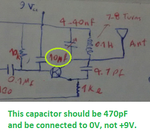J
Javid.zare.s
Guest
hi there, hope u r havin a nice day
I started to build mini fm transmitter -low range -minimalestic with 2n3904 for playing mp3 files on my phone through an aux cable to fm reciver of vehicle...
I came up with the following circuit and I faced some problems that I cant solve.
first of all I replaced mic with mono aux cable then I figured it out that voltage is almost 9 volts dc and 18 volts ac at the aux (so this will burn any smartphone right?)
second I couldnt find my transmiter on fm reciver, I found a strong station which is just buzzing and no other sound ...(power source was from pc 12vdc(maybe noicey but I regulated it using 78l09 ic))
third mics doesnt have polarity right?
fourth i couldnt find any trimmer cap so I used 2 diffrent capacitors with a switch(in theory I should have 2 stations)ok?
p.s. package is too small and I used aluminium as shield in the back.
antenna is the green wire inside the package(2inches or more)
if u see anything odd or stupid just tell me
circuit and
my design:


I started to build mini fm transmitter -low range -minimalestic with 2n3904 for playing mp3 files on my phone through an aux cable to fm reciver of vehicle...
I came up with the following circuit and I faced some problems that I cant solve.
first of all I replaced mic with mono aux cable then I figured it out that voltage is almost 9 volts dc and 18 volts ac at the aux (so this will burn any smartphone right?)
second I couldnt find my transmiter on fm reciver, I found a strong station which is just buzzing and no other sound ...(power source was from pc 12vdc(maybe noicey but I regulated it using 78l09 ic))
third mics doesnt have polarity right?
fourth i couldnt find any trimmer cap so I used 2 diffrent capacitors with a switch(in theory I should have 2 stations)ok?
p.s. package is too small and I used aluminium as shield in the back.
antenna is the green wire inside the package(2inches or more)
if u see anything odd or stupid just tell me
circuit and
my design:



Last edited:

